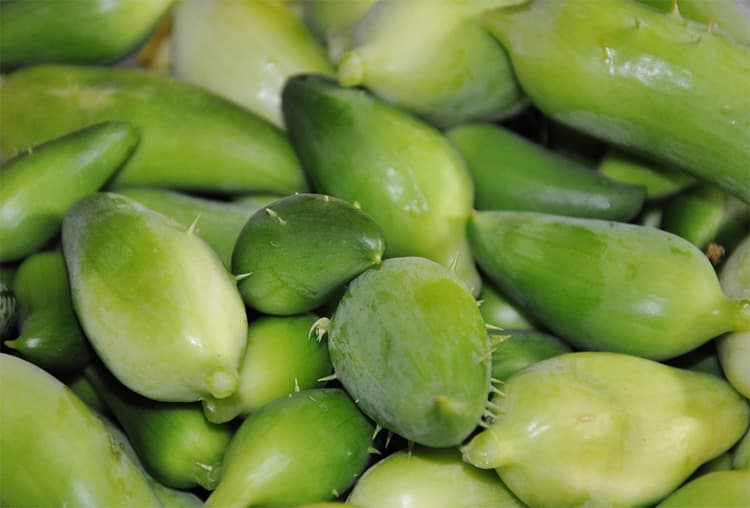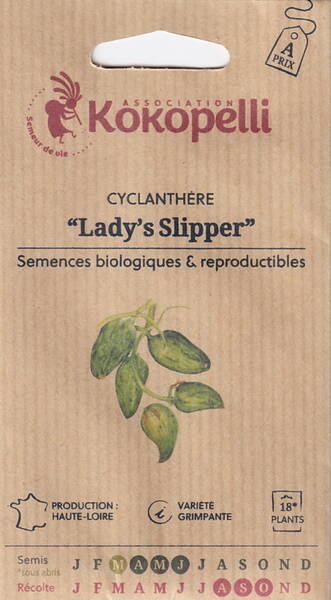(Peruvian Cucumber, Caigua) - Cyclanthera pedata.
Sowing time for seeds in open ground: late April - early May (when the soil at a depth of 10 cm warms up to +14°C).
Sowing depth: 1.5-2 cm.
Sowing scheme: seedlings are planted in a single row with a distance of 50-60 cm between plants.
Temperature regime: not very demanding of heat, the optimal temperature for growth and development of the crop is +15-20°C; at temperatures above +25°C, fruiting is delayed.
Watering: before flowering, water moderately, 3-4 liters per 1 m² every 5-7 days, and during flowering and fruiting every 2-3 days, 6-12 liters per 1 m² (depending on weather conditions).
* it is not recommended to water with a strong jet, otherwise the soil is washed away, and the root system, leaves, and stems are damaged.
Feeding: 3-5 feedings are carried out with mineral and organic fertilizers:
- the first feeding is done at the beginning of flowering (dissolve 1 tablespoon of complex mineral fertilizer like azophoska, 1 cup of slurry cow manure in 10 liters of water)
- during the fruiting period, feeding is carried out every 10-12 days (take 1 cup of slurry cow manure and 2 tablespoons of nitrophoska per 10 liters of water), water at the rate of 5-6 l/m²
- the last feeding is carried out 15-20 days before the last harvest
- fruiting in Estonian conditions begins no earlier than mid-August
- cyclanthera seeds can be used in the treatment of hypertension.
Predecessors: green manures (siderates), early cabbage and potatoes, tomatoes, legumes, onions (cannot be planted after pumpkin crops).
Cyclanthera can grow on any soil but prefers water-permeable, well-aerated, fertile soils of light mechanical composition: sandy loam and light loam. Heavy clay, waterproof, and acidic soils need preliminary improvement.
Does not tolerate high groundwater levels. Can be grown in open ground. Does not have high requirements for air temperature and humidity. For autumn digging, 5-6 kg of rotted manure or 6-8 kg of compost, 30 g of superphosphate, and 20 g of potassium sulfate are applied per 1 m², and in spring - 15-20 g of nitrogen fertilizer.

Cyclanthera (Cyclanthera pedata), or Peruvian cucumber, belongs to the pumpkin family.
It originates from South America, distributed in the mountains of Peru, Ecuador, and Brazil. Hence its love for heat and moisture, as well as the ability to set fruit in short daylight conditions. Cyclanthera was introduced into culture by the Incas a long time ago, but then it was forgotten, and only now have plant scientists shown interest in it.
Cyclanthera is a powerful annual herbaceous vine that has a large number of shoots with very dissected leaves, which give it special decorativeness and beauty. It pleases the eye throughout the summer and until late autumn and the first frosts.
It is a vine with shoots up to eight meters long, bright green, 7-8 lobed leaves, and small white flowers collected in small clusters. Its greenery is so dense that you can hide under it from the scorching sun in the garden.
In addition to decorative qualities, cyclanthera is also a vegetable crop. It blooms in late June - early July. Blooms for a long time and densely. Flowers are dioecious. Male flowers are very small, white, collected in small clusters, and female ones are slightly larger, yellowish. Fruits look like small peppers up to 7-10 cm long and 2-3 cm wide. In the leaf axil, they grow from 1 to 5, and on each vine 200-250 pieces. The taste of the fruit is pleasant and quite peculiar. It resembles the taste of cucumber, sweet pepper, and beans at the same time, with the taste of cucumber prevailing. Ripe fruits are wonderful in marinades and pickles (soaked). The taste of fried cyclanthera fruits resembles the taste of fried bean pods, only much tastier.
Cyclanthera fruits are also consumed fresh, making salads from them. However, they overripen very quickly, and if you are late with the harvest, they lose juiciness and become hard.
Cyclanthera is a valuable medicinal plant. Its fruits have a mild diuretic and choleretic property, increasing the secretory and motor functions of the stomach. It helps with anemia, atherosclerosis, diseases of the liver, kidneys, urolithiasis, heart diseases, stomach, and intestinal tract. It is also useful for patients with leg edema.













